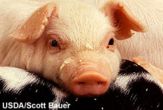Food Science: Building Better Steaks, Wings and 'Chops

AMES, Iowa (AP)—Max Rothschild has been trying to "build'' a better pig for almost 30 years, since he took a job cleaning up after the hogs at his alma mater, the University of California, Davis.
He's now a renowned swine scientist who has traded the dirty pigpens of his undergraduate days for a glistening Iowa State University laboratory dedicated to producing tastier chops, safer pork and healthier pigs.
Rothschild is part of a national collaboration that earlier this year received a $10 million federal grant to map pig genes. Researchers from the University of Illinois-led project promise it will help take the guesswork out of breeding.
The idea is to find and exploit the genetic variations of the best pigs, which Rothschild and like-minded agricultural researchers say will radically change the industry.
Already, chicken and cow genomes—complete genetic maps of each species—have been published, and race horse breeders have applied to the National Human Genome Research Institute for a grant to run an equine DNA sequence. Most animal genetic sequences are now done with the support of the institute because of its expertise, and comparing animal genomes to the human genome helps with medical research.
Mapping the roughly 30,000 genes in each animal requires extracting the genetic material from its blood. The DNA is then replicated many times over and run through a computer known as a sequencer, which spits out the swine's genetic makeup in a code of four letters—T, A, C, G—representing the nucleotides that comprise DNA.
Even before the pig genome is completed sometime next year, top commercial producers such as Pig Improvement Co. and Monsanto Inc. are using preliminary results from genetic screens to see if they can determine which pigs are the tastiest before they are butchered. The screens will also be used to manage herds and make breeding decisions, among other improvements.
Get the world’s most fascinating discoveries delivered straight to your inbox.
"They can now look inside the pig,'' Rothschild said. "They are both building better pigs with this technology.''
Rothschild previously discovered a gene variation that causes sows to produce more piglets per litter than average. He developed a test for the variation that is now widely used throughout the industry, and he said it could be useful in the Third World.
"The developing world wants to eat meat,'' Rothschild said. "And there's only one way to produce it—grow more animals.''
Rothschild also envisions a day when every farm animal is bar-coded, which would enable producers to better track their herds and more quickly trace the source of outbreaks like mad cow disease. The bar codes also would let the breeders pamper the top pigs with better feed and sort them from the run-of-the-mill animals.
Poultry producers and cattle ranchers are also developing genetic screens that will show them which animals are more prone to carry the best meat.
Minnesota-based Cargill Inc., which supplies about 20 percent of the nation's beef, is working on a genetic screen to sort its cattle by the quality of their meat, something that can't be done now until the animal is slaughtered.
Cargill is testing the screen on 30,000 of its cattle. If it works, the company can reserve the best feed and care for its prime beef producers, or ensure that the best animals mate with each other.
Animal breeding is still largely an art, rather than a science, despite centuries of practice.
"There is a lot of guesswork and shots in the dark when we are making breeding decisions,'' Cargill's Ben Brophy told executives and scientists at a biotechnology convention in Chicago on April 11. "Trends are definitely moving from a low-technology production to high-technology production.''
Developing tests that eliminate the vagaries of animal husbandry could increase the value of high-end cattle by $300, an increase of more than 30 percent. That's a significant premium in the low-margin cattle industry.
"That difference is substantial,'' Brophy said.
Using genetics to make scientific breeding decisions had remained an elusive goal until after President Clinton unveiled the Human Genome Project in a Rose Garden ceremony in 2000.
The announcement was the culmination of a $3 billion, 10-year project to identify every human gene, and expectations were high that the effort would soon produce medical breakthroughs. While the project has indeed yielded genetic clues to diseases and powerful diagnostic tests, most of the medical discoveries have been more incremental than dramatic.
Now, more powerful computers are being used to produce the genetic codes of all sorts of creatures in record time—and at lower costs. The chicken genome cost about $50 million and swine scientists said they can sequence the pig in a year for about $20 million.
"We are using the power of human genome tools to bring better food to the table,'' said Dennis Fantin, a vice president at the biotechnology company MetaMorphix Inc., which is developing genetic tests for chicken, beef, pig and even fish farmers. "We are using tools that weren't available 10 years ago.''


